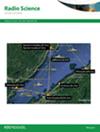Measurement and calibration of EMF: A study using phone and GBDT for mobile communication signals
IF 1.6
4区 地球科学
Q3 ASTRONOMY & ASTROPHYSICS
引用次数: 0
Abstract
Electromagnetic exposure caused by mobile communication signals has always been a cause of concern. Due to the cost and inconvenience of professional measurement equipment, researchers have turned to smartphone APPs to study and assess the electric field strength caused by mobile communication signals. However, existing cell phone-based measurements have two weaknesses. First, no system architecture suitable for large-scale crowdsourced testing has been proposed. Second, since smartphone sensors cannot measure electric field strength directly, existing methods for converting the received signal power of the phone and electric field strength have errors of more than 5 dB. This paper proposes a measurement and calibration method for electric field strength of mobile communication signals based on a smartphone app and gradient boosting decision tree (GBDT). This method consists of a downlink signal acquisition system based on an APP and a calibration model based on GBDT to convert received signal power into electric field strength. The experimental results show that the proposed model achieves a R 2 score of 0.93 and a MAE of 0.97 dB. Compared with the existing methods, our method improves the calibration accuracy by 4 dB, enabling large-scale, low-cost, and high-precision direct measurement of the electric field strength of mobile communication signals.电磁场的测量和校准:使用手机和 GBDT 测量移动通信信号的研究
移动通信信号造成的电磁暴露一直是一个令人担忧的问题。由于专业测量设备的成本和不便,研究人员转而使用智能手机 APP 来研究和评估移动通信信号造成的电场强度。然而,现有的基于手机的测量有两个弱点。首先,尚未提出适合大规模众包测试的系统架构。其次,由于智能手机传感器不能直接测量电场强度,现有的手机接收信号功率与电场强度的转换方法误差超过 5 dB。本文提出了一种基于智能手机应用程序和梯度提升决策树(GBDT)的移动通信信号电场强度测量和校准方法。该方法包括一个基于 APP 的下行链路信号采集系统和一个基于 GBDT 的校准模型,用于将接收到的信号功率转换为电场强度。实验结果表明,所提模型的 R2 得分为 0.93,MAE 为 0.97 dB。与现有方法相比,我们的方法将校准精度提高了 4 dB,实现了移动通信信号电场强度的大规模、低成本和高精度直接测量。
本文章由计算机程序翻译,如有差异,请以英文原文为准。
求助全文
约1分钟内获得全文
求助全文
来源期刊

Radio Science
工程技术-地球化学与地球物理
CiteScore
3.30
自引率
12.50%
发文量
112
审稿时长
1 months
期刊介绍:
Radio Science (RDS) publishes original scientific contributions on radio-frequency electromagnetic-propagation and its applications. Contributions covering measurement, modelling, prediction and forecasting techniques pertinent to fields and waves - including antennas, signals and systems, the terrestrial and space environment and radio propagation problems in radio astronomy - are welcome. Contributions may address propagation through, interaction with, and remote sensing of structures, geophysical media, plasmas, and materials, as well as the application of radio frequency electromagnetic techniques to remote sensing of the Earth and other bodies in the solar system.
 求助内容:
求助内容: 应助结果提醒方式:
应助结果提醒方式:


